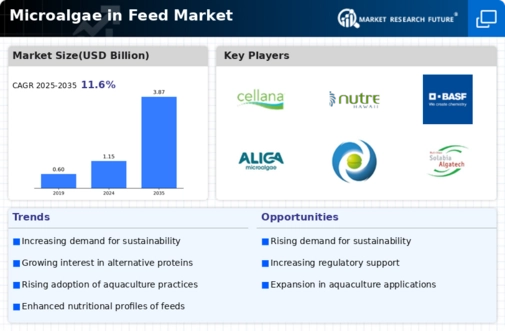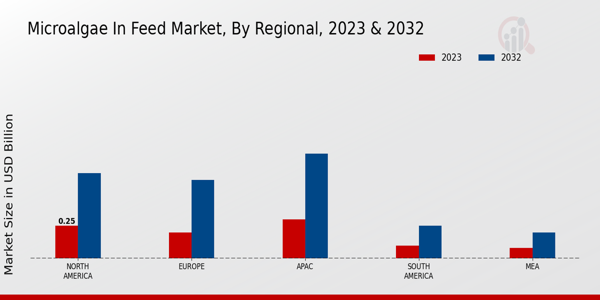Market Growth Projections
The Global Microalgae in Feed Market Industry is poised for substantial growth, with projections indicating a market value of 3.87 USD Billion by 2035. This anticipated growth is underpinned by a compound annual growth rate (CAGR) of 11.67% from 2025 to 2035. The increasing adoption of microalgae in various feed applications, coupled with rising consumer demand for sustainable and nutritious feed alternatives, suggests a robust market trajectory. As stakeholders across the agricultural sector recognize the potential of microalgae, investments in research and development are likely to increase, further driving innovation and market expansion.
Consumer Awareness and Education
Consumer awareness and education regarding the benefits of microalgae in animal feed are crucial drivers in the Global Microalgae in Feed Market Industry. As consumers increasingly seek transparency in food production, the nutritional advantages of microalgae are becoming more recognized. Educational campaigns highlighting the health benefits of microalgae for livestock and aquaculture species are gaining momentum. This heightened awareness is likely to influence purchasing decisions among feed manufacturers, who may prioritize microalgae as a key ingredient in their formulations. As consumer preferences shift towards healthier and more sustainable options, the demand for microalgae in feed is expected to rise, further propelling market growth.
Nutritional Benefits of Microalgae
Microalgae offer numerous nutritional benefits that contribute to their rising popularity in the Global Microalgae in Feed Market Industry. They are a rich source of proteins, omega-3 fatty acids, vitamins, and minerals, which enhance the overall health of livestock and aquaculture species. For instance, incorporating microalgae into fish feed has been shown to improve growth rates and immune responses in various fish species. This nutritional advantage positions microalgae as a preferred ingredient among feed manufacturers, who are increasingly seeking to enhance the quality of their products. As the demand for high-quality feed continues to grow, microalgae are likely to play a pivotal role in meeting these nutritional needs.
Regulatory Support for Sustainable Practices
The Global Microalgae in Feed Market Industry benefits from increasing regulatory support aimed at promoting sustainable agricultural practices. Governments worldwide are implementing policies that encourage the use of alternative feed sources, including microalgae, to reduce the environmental impact of livestock production. For example, initiatives that support research and development in sustainable feed technologies are gaining traction. This regulatory environment not only fosters innovation but also enhances market accessibility for microalgae-based products. As regulations become more favorable, the adoption of microalgae in feed is expected to rise, further driving market growth and contributing to a more sustainable food system.
Rising Demand for Sustainable Feed Alternatives
The Global Microalgae in Feed Market Industry experiences a notable increase in demand for sustainable feed alternatives. As consumers become more environmentally conscious, the shift towards plant-based and sustainable protein sources is evident. Microalgae, rich in essential nutrients, provide a viable solution to meet this demand. In 2024, the market is valued at approximately 1.15 USD Billion, reflecting the growing interest in sustainable practices within the agricultural sector. This trend is likely to continue, as projections indicate a market growth to 3.87 USD Billion by 2035, with a compound annual growth rate (CAGR) of 11.67% from 2025 to 2035.
Technological Advancements in Microalgae Cultivation
Technological advancements in microalgae cultivation techniques are significantly influencing the Global Microalgae in Feed Market Industry. Innovations such as photobioreactors and improved harvesting methods enhance the efficiency and yield of microalgae production. These advancements reduce production costs and make microalgae a more competitive ingredient in feed formulations. As technology continues to evolve, the scalability of microalgae production is likely to improve, allowing for greater market penetration. This trend could lead to a broader acceptance of microalgae in various feed applications, thereby supporting the anticipated market growth from 1.15 USD Billion in 2024 to 3.87 USD Billion by 2035.




















Leave a Comment